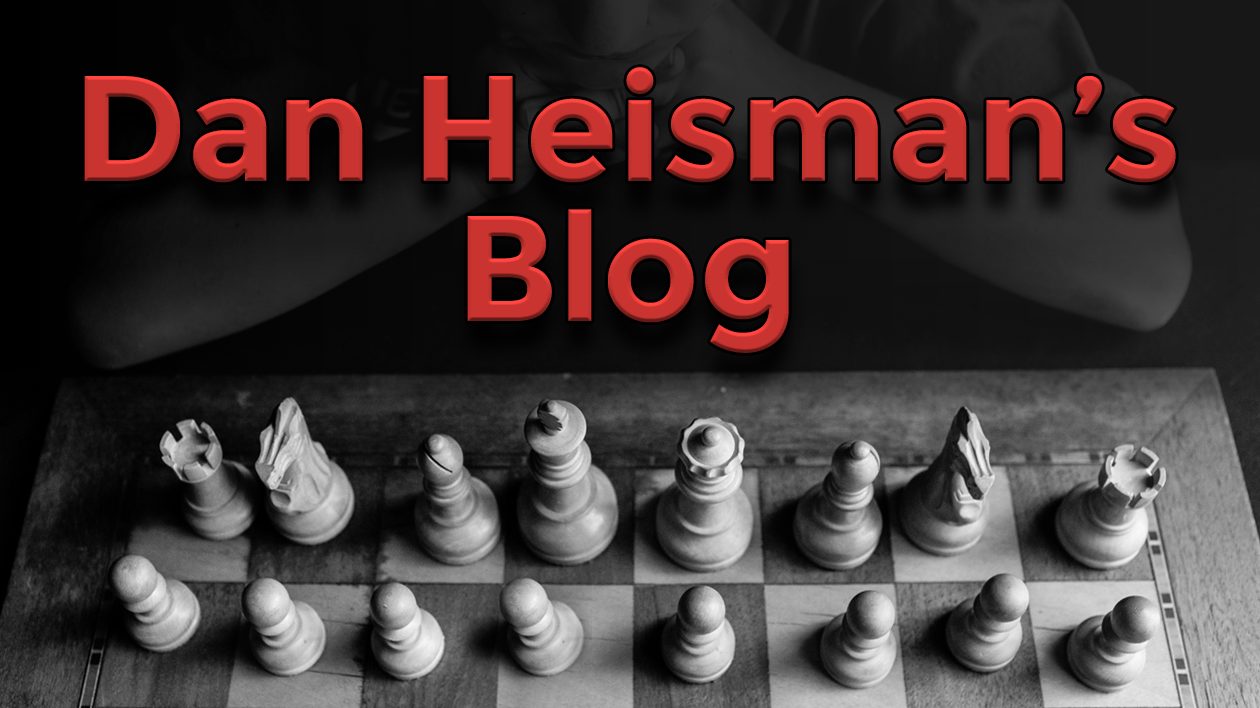
How I won more games by improving my chess thought process
I am pleased to present another helpful article on chess improvement by one of my students who had some recent success. Hope you find this interesting and helpful (- Dan H)
How I won more games by improving my chess thought process
By Jason Murray
I am a typical adult improver who took the game up a few years ago, after playing seriously in my youth. I love the game and study diligently, mostly tactics. I also take lessons from a strong, reputable coach (Dan Heisman) and play my share of games OTB and online.
But somehow, I have been stuck in the 1200-1300 range for 18 months and have been increasingly frustrated that my hard work has not paid off with more wins and ratings gains. I consider myself bright and have excelled in many other intellectual pursuits, including a very intellectually demanding career.
I found myself over and over again either missing offensive tactics that should have been obvious. I got so frustrated and angry I stopped to ask why.
Why am I not progressing despite spending hours each week in effective study, good coaching and many games?
The realization I came to is that despite acquiring knowledge I was not able to apply this in games. Somehow, I was not looking for the tactics or able to spot them despite being able to solve similar problems in practice!
The only conclusion I could come to was that my thought process, or the way I approached a move, would not allow me to see the things I needed to. I realized I had read some things about this but never really implemented them.
When I paid attention to my thought process during a game I realized I never took a break and just kept doing tactical analysis the whole time, including while on the other guys clock. I was constantly trying to see deeper and further ahead, even when I was trying to see well beyond my visualization ability or when my opponent had many possible answers to my moves. When he did move, I would look briefly at his move and go back to my analysis. This left me exhausted, often in unnecessary time trouble and losing games.
I did some research on this including Dan’s excellent Novice Nook “Keeping Chess Simple” (appearing in his novice nook anthology “A Guide To Chess Improvement” and his video “Thought Process five essential steps” . I also discussed this with knowledgeable people in several online chess forums.
Pretty quickly I was able to come up with what seemed like a pretty effective thought process.
And could not seem to implement it for the life of me!
I played a series of games against a weak computer with the only goal of working through the thought process on every move. But I found time and time again my brain jumped around from move to move and never followed the process. I simply could not do it. My brain just kept following the old, bad habits it was used to!
I am very fortunate to work at a big hospital and called a Psychologist colleague. He recognized I was getting lost in thought and we identified that during a chess move cycle there are really only two cues to work off of; your move and your opponent’s move. He also talked to me about grounding exercises (https://www.talkspace.com/blog/grounding-techniques-anxiety/) and how those could take me out of what I was thinking.
I also reviewed Dan’s superb video on “Thinking on Your Opponents Time” (https://www.youtube.com/watch?v=FD7mZYrPXtw) so I could be clear on what I want to do while his clock is running. You can (and should) watch the video but suffice to say it is not trying to calculate when he has multiple good moves in reply to you.
It was here that things started to take a turn for the good and I found I could systematically apply what I knew.
So, I started to take a deep breath and wiggle my toes every time I make a move. As odd as this sounds it resets my thinking. I then think about the strategy, clock and other things Dan suggests for you to do while thinking on your opponent's clock.
When the opponent moves and I’m on my time I do the same things. Breath. Toes. Then ask what are ALL the things my opponent's move does for him? And ask myself several times “and what else?” to make sure I am seeing everything.
Then I ask myself what I want to accomplish with this move?
Then I look at candidate moves, and my rule is now there MUST be more than one, unless it is an exceptional circumstance such as a forced move, mate etc.
Then and only then do I start to analyze the candidate moves.
Once I have finished that analysis, I do a safety check, make my move and repeat the toes and breath.
Once I started using my move and the opponents to trigger my new thought process, I found I saw much much MUCH more in my positions and got surprised much less often! My chess really took a turn for the good.
While I still miss things and have problems in my analysis, they are the problems I would expect to have! It is not missing obvious things that make me sick and crush my rating!
I hope this is helpful for others.